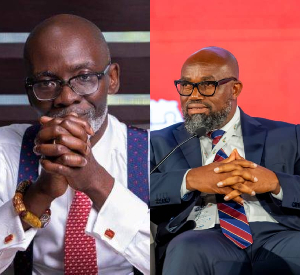Ghana has always been described as a beacon of peace in sub-Saharan Africa.
But the peace is not enjoyed in equal measure across in the country.
There are places where pockets of violence erupt from time to time necessitating actions like the imposition of curfews.
These violence caused by land, chieftaincy and/or political disputes, have somewhat turned such towns into dangerous places to live compared to other areas in the country.
Here are five such relatively dangerous towns in Ghana:
1. Nkonya/Alavanyo:
Nkonya and Alavanyo are very close settlements in the Volta Region which could have been described as another Sekondi-Takoradi if they were big enough.
But unlike the Western regional capital, they do not live in peace.
An age-long land dispute has ensured that the towns have always been in the news for the wrong reasons.
The story behind the dispute is that is the Alavanyo's were given their present location by the Nkonya's who had settled in the area earlier.
After sometime, some Alavanyo farmers encroached on lands not given them.
The dispute is about a century old as the first violent conflicts were recorded in 1923 with others occurring in 1983, 2003, 2004 and 2012 and 2013.
The most recent one, which broke out this year, has seen a number of people killed and some of these murders have been committed even under a strict enforcement of a dusk till dawn curfew.
The situation has been so bad the Regional House of Chiefs, in April, suspended the traditional leaders of the two towns for failing to deal with the escalating violence.
Though relative calm has returned with the presence of security personnel, it is still very dangerous to live in any of the towns as their conflicts easily triggered by the trivial actions of each other.
2. Bimbilla:
This is the capital town of the Nanumba North District of the Northern Region.
It has been riddled with conflicts for the most part of the last three decades.
It is in this area that the infamous Nanumba-Konkomba war which reportedly claimed about 2,000 people were lives, and displaced over 150,000.
It is known that the war, in 1994, was started after a Konkomba man killed a Nanumba becuase he outbid him in the purchase of a guinea fowl.
It is known that the war, in 1994, was started after a Konkomba man killed a Nanumba because he outbid him in the purchase of a guinea fowl.
Apart from the inter-ethnic feud, there is also the case of chieftaincy dispute between the Andani and Nakpa Naa gates over the legitimate person to be enskinned as the next chief of the town.
These tensions has seen the town put under different typres of curfews in the last 10 years.
Though the curfews have brought an uneasy calm, there is every chance of violence breaking out at any time.
3. Bawku:
Bawku is the capital of the Bawku Municipal area and is one of the biggest towns in the Upper East Region.
It has, in the recent past, become known for the violent clashes the often occur in the town. Though many of the clashes seem political, underpinning them is a chieftaincy dispute which was created by colonial authorities.
Bawku is a land dominated by Kusasis but was put under the care of the Nayiri (Mamprusi overlord) in Nalerigu in the Northern region for administrative convenience.
But being an acephalous society, the Kusasis only had regard for a 'tendana' (spiritual leader) and have since struggled to accept the physicial leadership of the Mamprusi overlord.
So the conflict, basically, is one bothering on the legitimacy to rule the area and the resources that come with such power which has turned political because the two Kusasis and Maprusis have aligned themselves to the NDC and NPP respectively.
Despite the regular presence of security men in the area, the least provocation from any of the groups against the other ends up in violent clashes and it does not seem it will abate anytime soon.
4. Bunkprugu Yunyoo:
This is a district in the Northern Region which is also noted for regular violent clashes.
Settlements like Nankpanduri, Kpamele, Teima, and Jimbale have often seen clashes between Bimobas and and Konkombas over land disputes.
One occured at Kpamele where a misunderstanding between a Konkomba man and a Bimoba man over a piece of land meant for the construction of a school led the two groups to engage in sporadic shootings and the burning down of houses.
The most recent clash in the area occured in April at Nankpanduri where a land dispute led to the death of four people including a chief.
This altercation came just a week after the a ceremony which was supposed to have brought and end to such clashes in the district.
The area has since then been in and out of curfews.
5. Yendi (Dagbon):
Since the death of the overlord of the Dagbon Traditional area, Ya-Na Yakubu Andani in 2002, the town of Yendi, the capital Dagbon, has been under and uneasy calm.
There existed a recurring chieftaincy dispute between the Abudus and Andanis with political undertones. The Abudus are said to be pro-NPP and the Andanis, pro-NDC.
But death of an Andani Ya-Na during the early years of former President J.A. Kufuor's administration was deemed by members of that gate as a politcally ochestrated move to put an Abudu on the throne.
The fact that Kufuor had Abudus Vice President late Aliu Mahama; Interior Minister Malik Alhassan; and Security Adviser General (rtd) Joshua Hamidu in his government coupled with the inability to bring the murder culprits to book made it difficult to ignore the claims of the Andanis.
Peace in the area, often maintained by security forces, has thus become so tenous that any misunderstanding between individuals of the two gates under whatever circumstance triggers the conflict sometimes spilling over to other areas of the Dagbon traditional area.
General News of Saturday, 2 December 2017
Source: yen.com.gh













